Hokkaido
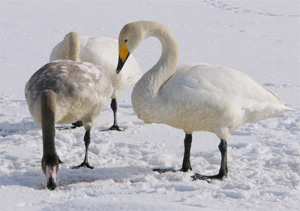
Whooper Swans
February 4th dawned and our first stop was Utonai-ko. There is a nice nature centre here with feeders, many books, both in their for-visitors library and to buy (although they don't take credit cards or foreign currency), and a heated floor. The feeders brought the birds close and we admired Great, Willow and Marsh Tits, Japanese Pygmy Woodpecker, Common Nuthatch, Eurasian Tree Sparrow and a pair of Great Spotted Woodpeckers. Also here, but not at feeders, we saw Black Kites, Dusky Thrushes and Large-billed Crows, and, on the actual lake 34 Whooper Swans and about 150 Northern Pintails. The biggest surprise was a Black-billed Magpie seen in Tomakomai, probably an introduced bird.
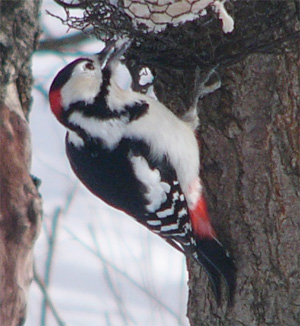
Great Spotted Woodpecker
Now it was time for the drive across Hokkaido to the town of Akan. En route we kept our eyes open and were rewarded when Graham spotted some eagles and we stopped to admire our first, if a bit distant, Steller's Sea-eagles, two adults, and a White-tailed Eagle. Common Buzzard was the only other bird of note seen on the drive.
As we approached Akan we scanned the fields in the hope of finding our first Red-crowned Cranes. We saw none driving into Akan and were soon stopped in a carpark and then walking into a building that turned out to be the crane-feeding centre of the area. The actual cranes, although very good to see, where a bit of a disappointment as it felt like watching captive ducks in a wildfowl reserve. The birds are admittedly very close and separated from the watcher only by a chest-high concrete wall. They are fed regularly during the winter and have become rather used to humans. In total we saw between 130 and 160 of these rare birds. Also here were a couple of White-tailed Eagles, left over from the feeding session earlier that afternoon, about 50 Eurasian Tree Sparrows and a Black-backed Wagtail.
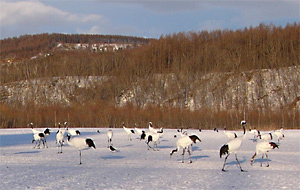
Red-crowned Cranes
As we were leaving Armas said he had got the last three rooms in a nearby hotel. This meant I had to share a room with him, although I had paid single supplement. Still, anything to help out, and Armas did say he'd ask again at the front desk to ensure there were no more rooms.. As I waited for our room to be prepared Graham walked past and told me the room he was supposed to share with our two Dutch friends was too small so he'd asked at the desk and they'd given him another room. As you can imagine I was slightly put out by this piece of news and by the fact that the tour leader had apparently lied to me to save money. I gave him the benefit of the doubt (although I am not sure there was any doubt) and we shared a room as Graham reclined in splendid isolation.
Next morning, February 5th, we did a walk around the town and the crane place. Only a singel crane was seen this time but we did pick up eight Whooper Swans, a Eurasian Treecreeper, two Goldcrests and a Great Tit, plus the ubiquitous Large-billed Crow. After breakfast we drove to Kushiro and birded a river, where we saw a flock of Goosanders and about 50 European Goldeneye and some Eurasian Wigeon. Next stop was Akkeshi Bay where we were soon watching beautiful Harlequins and Long-tailed Ducks. 'Scoping the sea added good views of a flock of about 300 Black Scoters, about 200 distant Red-breasted Mergansers, Glaucous and Slaty-backed Gulls and some distant Steller's Sea-eagles plus a Kurile Seal.
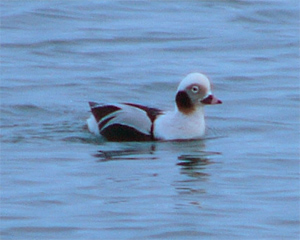
Long-tailed Duck
Our next stop was a headland near the town of Kiritappu. Despite being cold this was a good stop with more Glaucous, Glaucous-winged and Slaty-backed Gulls, about 10 Dusky Thrushes and a bonus bird in the form of a grey-phase Gyrfalcon – thanks to Peter for that one. The sea was good with small flocks of Harlequins and Black Scoters being common on the water, alongside Pelagic Cormorants and five male and two females of the distinctive stejnegeri race of Velvet or White-winged Scoter – surely a species in its own right.
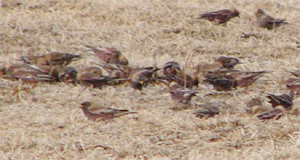
Asian Rosyfinches
Continuing along the coast we briefly saw a small flock of Asian Rosyfinches fly across the front of the van but couldn't relocate them. A little later we found another flock of this species, this time about 100 individuals. We stopped and walked to where they had been seen, on a windy and cold field on a hill, and were soon watching these sometimes flightly birds fly between small bushes and open ground where they were feeding. They gave excellent views and are very good-looking birds.
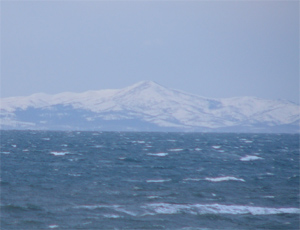
One of the Kurile Islands
from Hokkaido
As we drove through and past Nemuro, where the Russian Kurile Islands are so close that many of the road signs are in Japanese and Russian, we saw a small flock of gulls, comprising Glaucous, Glaucous-winged and Slaty-backed, and admired eight sitting and flying Steller's Sea-eagles and three White-tailed Eagles. As the light began to go we drove to a nearby site Armas knew. The entrance was marked with a small sign with an owl on it. We parked and waited. Darkness fell and our only entertainment was a barking dog. Another car arrived and they too sat there waiting. Someone came out of a house, spoke to Armas, and went back in again. As we had almost given up hope a man appeared and took the three birders that had arrived after us off into the darkness. A couple of minutes later they returned and drove off. We were then ushered only a few metres from the van and had our gaze directed along the path of a beam from a fairly weak torch. At the end of this was a post and on the post was a Blakiston's Eagle-owl! As we watched another bird flew in and displaced the first. Unfortunately photography was not allowed. After a few minuted both birds flew off and we heard them calling. We were mightily relieved to be successful with the owl.
We spent the night at the Notsuke Horse Riding Farm, a delightful and very Japanese hotel run by very nice people.
Next morning a scan across the bay to the peninsular that curves out into the sea gave us Slaty-backed and Glaucous Gulls, Red-breasted Mergansers and Goosanders, European Goldeneyes, nine distant Steller's Sea-eagles and Long-tailed Ducks. The area around the hotel gave us Eurasian Tree Sparrows.
We drove up the coast a little way to another fishing village where we saw a raft of duck by the harbour arm. We found a good place to park on the snow-covered waterfront and scanned the ducks. There were about 206 Greater Scaup and two male Falcated Ducks. A bit further out were a few Goosanders and close in we found a family of Whooper Swans. Further grilling of the flock added two male and one female Northern Shoveler, a pair of Northern Pintail and a peculiar-looking female Pochard that may have been a hybrid but which could not be turned into a Canvasback!
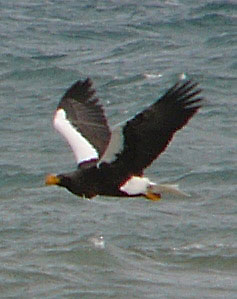
Steller's Sea-eagle
Next we drove the length of the peninsular. The gulls were mostly Slaty-backed and Glaucous, with a few Common (Kamchatka) Gulls. For those of us used to seeing one or two Glaucous Gulls at a time or in a year the sight of what was eventually hundreds was impressive. Steller's Sea-eagles were also abundant, mostly sitting out on the frozen water of the inner bay. We were to see at least 100 of these birds today. There were far fewer White-tailed Eagles around but those that were showed well as they stayed on the land rather than out on the ice. We also picked up three Dunlin of the sakhalinensis race. The sea on the unfrozen Kurile side of the peninsular held both Black and Stejneger's Scoter and Red-breasted Merganser. Passerines were rare and we saw only six Oriental Greenfinches, about 30 Asian Rosyfinches and, of course, Large-billed Crows.
Back on the main coast road we again headed north, this time to Chisho where we were again soon standing on the edge of the water checking the large gull flocks and hunting for seabirds. As ever, Slaty-backed and Glaucous Gulls were abundant, with the occasional Glaucous-winged Gull being sighted. We had one target bird here and it was proving very elusive. As we searched we found Harlequins, Pelagic Cormorant and both Common and Brunnich's Guillemots. Armas announced he had found our target bird, a Spectacled Guillemot. A few minutes searching failed to produce the bird but our persistence paid off when it was finally relocated and eventually seen by all, albeit rather distantly. We managed to find another as we tried to get everyone on the first bird.
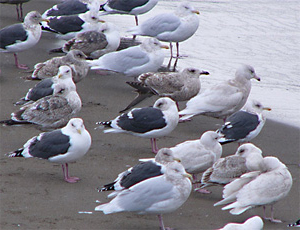
Glaucous and Slaty-backed Gulls
At another stop, yet further up the coast, we found another Spectacled Guillemot, one presumed Pacific Diver, Harlequins and more Steller's Sea-eagles. A head appeared above the water and some of us managed to see the huge body of a female Steller's Sealion. Not as large as the male but still noticeably larger than the Kurile Seals we were occasionally finding.
During a brief stop on a bridge overlooking a river we picked up a new gull for Hokkaido, Black-headed Gull, plus four male and a female Smew.
Heading back down the coast to our hotel we saw lots more Steller's Sea-eagles in trees overlooking the road and sea and a few White-tailed Eagles. A Brown Dipper was seen on a river, as were yet more Steller's. At a further stop in another fishing town, where we were again checking the harbour, we noticed what looked like a group of cormorants along a rather distant harbour arm. We drove round to as near as we could get and, as the sun was going down, watched 1000+ Pelagic Cormorants and 101 Goosanders. Also here, Ian spotted our first Tufted Duck amongst a group of Greater Scaup.
The morning of the 7th of February dawned and we were soon on our way to Kushiro for our flight to Haneda, Tokyo. We did a non-stop drive and were soon sitting in the airport waiting for Armas to get us booked in. We waited for over half an hour until Armas appeared and announced that there was a problem. We heard some rather confused story about the flights being on JAL's computer but we could not fly because we didn't have hardcopy tickets and that it was not possible to e-ticket internal flights in Japan from the US, despite, we were told, Armas's travel agent having done so. The key point came when Armas told us he had to buy tickets and could afford only four of the seven. At first we sat there in shock, not really believing what we were being told. However, the choice was clear – no pay, no flight! Graham told us later that he had heard many rumours that Armas was known to run out of money during trips but none of us could have suspected the extent of this problem.
After Armas had promised to repay me promptly I put the three tickets on my credit card and we left Hokkaido. On arrival at Haneda we went to the bullet train station where it turned out that Armas had not booked tickets and so we were seven tickets short with a leader with no money. Out came the credit card again and two hours later we were in Kyoto. We later found out that Armas's technique for funding the trip was to have some kind of credit/charge card account into which his wife put money each day. He then used that money to get us around and pay for food. On Mondays, it was Sunday in the US so no money was transferred although we couldn't see how a Monday could come as a surprise. Nevertheless, Armas' card seemed to work when he came to hire a van and after a lengthy wait at the airport (another unfortunate pattern of the trip) we were asked to load up in a cramped van that we were assured was the largest available. We drove straight to the Sunbridge Hotel, Imazu, at the north end of Lake Bi-wa.

